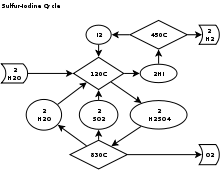Sulfur–iodine cycle

The sulfur–iodine cycle (S–I cycle) is a three-step thermochemical cycle used to produce hydrogen.
The S–I cycle consists of three chemical reactions whose net reactant is water and whose net products are hydrogen and oxygen. All other chemicals are recycled. The S–I process requires an efficient source of heat.
Process description
| H2O | ½O2 | |||||
| ↓ | ↑ | |||||
| I2 | → | Reaction 1 | ← | SO2+H2O | ← | Separate |
| ↑ | ↓ | ↑ | ||||
| 2HI | ← | Separate | → | H2SO4 | → | Reaction 2 |
| ↓ | ||||||
| H2 |
The three reactions that produce hydrogen are as follows:
- I2 + SO2 + 2 H2O → 2 HI + H2SO4 (120 °C); Bunsen reaction
- The HI is then separated by distillation or liquid/liquid gravitic separation.
- 2 H2SO4 → 2 SO2 + 2 H2O + O2 (830 °C)
- The water, SO2 and residual H2SO4 must be separated from the oxygen byproduct by condensation.
- 2 HI → I2 + H2 (450 °C)
- Iodine and any accompanying water or SO2 are separated by condensation, and the hydrogen product remains as a gas.
- Net reaction: 2 H2O → 2 H2 + O2
The sulfur and iodine compounds are recovered and reused, hence the consideration of the process as a cycle. This S–I process is a chemical heat engine. Heat enters the cycle in high-temperature endothermic chemical reactions 2 and 3, and heat exits the cycle in the low-temperature exothermic reaction 1. The difference between the heat entering and leaving the cycle exits the cycle in the form of the heat of combustion of the hydrogen produced.
Advantages and disadvantages
The characteristics of the S–I process can be described as follows:
- All fluid (liquids, gases) process, therefore well suited for continuous operation;
- High utilization of heat predicted (about 50%), but very high temperatures required (at least 850 °C);
- Completely closed system without byproducts or effluents (besides hydrogen and oxygen);
- Corrosive reagents used as intermediaries (iodine, sulfur dioxide, hydriodic acid, sulfuric acid); therefore, advanced materials needed for construction of process apparatus;
- Suitable for application with solar, nuclear, and hybrid (e.g., solar-fossil) sources of heat;
- More developed than competitive thermochemical processes (but still requiring significant development to be feasible on large scale).
Research
The S–I cycle was invented at General Atomics in the 1970s.[1] The Japan Atomic Energy Agency (JAEA) has conducted successful experiments with the S–I cycle in the Helium cooled High Temperature Test Reactor,[2][3][4][5] a reactor which reached first criticality in 1998, JAEA have the aspiration of using further nuclear high-temperature generation IV reactors to produce industrial scale quantities of hydrogen. (The Japanese refer to the cycle as the IS cycle.) Plans have been made to test larger-scale automated systems for hydrogen production. Under an International Nuclear Energy Research Initiative (INERI) agreement, the French CEA, General Atomics and Sandia National Laboratories are jointly developing the sulfur-iodine process. Additional research is taking place at the Idaho National Laboratory, in Canada, Korea and Italy.
Material challenge
The S–I cycle involves operations with corrosive chemicals at temperatures up to about 1,000 °C (1,830 °F). The selection of materials with sufficient corrosion resistance under the process conditions is of key importance to the economic viability of this process. The materials suggested include the following classes: refractory metals, reactive metals, superalloys, ceramics, polymers, and coatings.[6][7] Some materials suggested include tantalum alloys, niobium alloys, noble metals, high-silicon steels,[8] several nickel-based superalloys, mullite, silicon carbide (SiC), glass, silicon nitride (Si3N4), and others. Recent research on scaled prototyping suggests that new tantalum surface technologies may be a technically and economically feasible way to make larger scale installations.[9]
Hydrogen economy
The sulfur-iodine cycle has been proposed as a way to supply hydrogen for a hydrogen-based economy. It does not require hydrocarbons like current methods of steam reforming but requires heat from combustion, nuclear reactions, or solar heat concentrators.
See also
- Cerium(IV) oxide–cerium(III) oxide cycle
- Copper–chlorine cycle
- Hybrid sulfur cycle
- High-temperature electrolysis
- Iron oxide cycle
- Zinc–zinc oxide cycle
Footnotes
- ↑ Besenbruch, G. 1982. General Atomic sulfur iodine thermochemical water-splitting process. Proceedings of the American Chemical Society, Div. Pet. Chem., 27(1):48-53.
- ↑ "HTTR High Temperature engineering Test Reactor". Httr.jaea.go.jp. Retrieved 2014-01-23.
- ↑ https://smr.inl.gov/Document.ashx?path=DOCS%2FGCR-Int%2FNHDDELDER.pdf. Progress in Nuclear Energy Nuclear heat for hydrogen production: Coupling a very high/high temperature reactor to a hydrogen production plant. 2009
- ↑ Status report 101 - Gas Turbine High Temperature Reactor (GTHTR300C)
- ↑ JAEA’S VHTR FOR HYDROGEN AND ELECTRICITY COGENERATION : GTHTR300C
- ↑ Paul Pickard, Sulfur-Iodine Thermochemical Cycle 2005 DOE Hydrogen Program Review
- ↑ Wonga, B.; Buckingham, R. T.; Brown, L. C.; Russ, B. E.; Besenbruch, G. E.; Kaiparambil, A.; Santhanakrishnan, R.; Roy, Ajit (2007). "Construction materials development in sulfur–iodine thermochemical water-splitting process for hydrogen production". International Journal of Hydrogen Energy 32 (4): 497–504. doi:10.1016/j.ijhydene.2006.06.058.
- ↑ Saramet info sheet
- ↑ T. Drake, B. E. Russ, L. Brown, G. Besenbruch, "Tantalum Applications For Use In Scale Sulfur-Iodine Experiments", AIChE 2007 Fall Annual Meeting, 566a.
References
- Paul M. Mathias and Lloyd C. Brown "Thermodynamics of the Sulfur-Iodine Cycle for Thermochemical Hydrogen Production", presented at the 68 th Annual Meeting of the Society of Chemical Engineers, Japan 23 March 2003. (PDF).
- Atsuhiko TERADA; Jin IWATSUKI, Shuichi ISHIKURA, Hiroki NOGUCHI, Shinji KUBO, Hiroyuki OKUDA, Seiji KASAHARA, Nobuyuki TANAKA, Hiroyuki OTA, Kaoru ONUKI and Ryutaro HINO, "Development of Hydrogen Production Technology by Thermochemical Water Splitting IS Process Pilot Test Plan", Journal of Nuclear Science and Technology, Vol.44, No.3, p. 477–482 (2007). (PDF).
External links
- Hydrogen: Our Future made with Nuclear (in MPR Profile issue 9)
- Use of the modular helium reactor for hydrogen production (World Nuclear Association Symposium 2003)